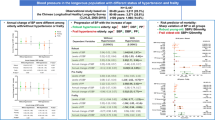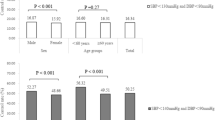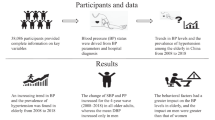Abstract
Systolic blood pressure (SBP) and pulse pressure (PP) have been identified in western industrialized countries as major predictors of cardiovascular events in the elderly on the basis of measurements taken at a single visit. Considering the wide variability of blood pressure (BP) in older people, this study set out to assess the prognostic significance of measurements of SBP and PP taken over several months according to a monitoring scheme mimicking routine care. A total of 444 Italian general practitioners enrolled a cohort of 3858 unselected elderly outpatients and followed them up for 10 years. BP was recorded at recruitment, 1 week later and at quarterly visits during the first year. The average BP of these six visits was used to define the patient's BP status. During the 10-year follow-up, 1561 participants died, 709 from cardiovascular diseases. Proportional hazard regression analysis, adjusted for all main prognostic factors including antihypertensive treatment, showed that for each 10-mmHg increment in SBP and PP there were, respectively, 5 and 9% increases in risk for total mortality (TM) and 9 and 13% increases in risk for cardiovascular mortality (CVM) (all P<0.01). However, including both SBP and PP in the model, only PP showed an independent, significant relationship with TM and CVM. In conclusion, prognostic information based on repeated measurements of PP is stronger than that given by SBP and consequently should be recommended in the definition of cardiovascular risk in the elderly.
This is a preview of subscription content, access via your institution
Access options
Subscribe to this journal
Receive 12 digital issues and online access to articles
$119.00 per year
only $9.92 per issue
Buy this article
- Purchase on SpringerLink
- Instant access to full article PDF
Prices may be subject to local taxes which are calculated during checkout




Similar content being viewed by others
References
Franklin SS et al. Hemodynamic patterns of age-related changes in blood pressure. The Framingham Heart Study. Circulation 1997; 96: 308–315.
Dart AM, Kingwell BA . Pulse pressure. A review of mechanism and clinical relevance. J Am Coll Cardiol 2001; 37: 975–984.
Darne B et al. Pulsatile versus steady component of blood pressure: a cross-sectional analysis and a prospective analysis on cardiovascular mortality. Hypertension 1989; 13: 392–400.
Madhavan S, Lock Ooi W, Cohen H, Alderman MH . Relation of pulse pressure and blood pressure reduction to the incidence of myocardial infarction. Hypertension 1994; 23: 395–401.
Benetos A et al. Pulse pressure: a predictor of long-term cardiovascular mortality in a French male population. Hypertension 1997; 30: 1410–1415.
Verdecchia P et al. Ambulatory pulse pressure. A potent predictor of total cardiovascolar risk in hypertension. Hypertension 1998; 32: 983–988.
Franklin SS et al. Is pulse pressure useful in predicting risk for coronary heart disease? The Framingham Heart Study. Circulation 1999; 100: 354–360.
Chae CU et al. Increased pulse pressure and risk of heart failure in the elderly. JAMA 1999; 281: 634–639.
Glynn RJ et al. Pulse pressure and mortality in older people. Arch Intern Med 2000; 160: 2765–2772.
Vaccarino V, Holford TR, Krumholz HM . Pulse pressure and risk for myocardial infarction and heart failure in the elderly. J Am Coll Cardiol 2000; 36: 130–138.
Khattar RS et al. Effect of aging on the prognostic significance of ambulatory systolic, diastolic, and pulse pressure in essential hypertension. Circulation 2001; 104: 783–789.
Millar JA, Lever AF, Burke V . Pulse pressure as a risk factor for cardiovascular events in the MRC Mild Hypertension Trial. J Hypertens 1999; 17: 1065–1072.
Domanski MJ et al. Isolated systolic hypertension. Prognostic information provided by pulse pressure. Hypertension 1999; 34: 375–380.
Lee ML, Rosner BA, Weiss ST . Relationship of blood pressure to cardiovascular death: the effects of pulse pressure in the elderly. Ann Epidemiol 1999; 9: 101–107.
Blacher J et al. Pulse pressure not mean pressure determines cardiovascular risk in older hypertensive patients. Arch Intern Med 2000; 160: 1085–1089.
Domanski M et al. Cardiovascular risk assessment using pulse pressure in the First National Health and Nutrition Examination Survey (NHANES I). Hypertension 2001; 38: 793–797.
Mitchell GF, et al., for the SAVE Investigators. Sphygmomanometrically determined pulse pressure is a powerful independent predictor of recurrent events after myocardial infarction in patients with impaired left ventricular function. Circulation 1997; 96: 4254–4260.
Domanski MJ et al. Independent prognostic information provided by sphygmomanometrically determined pulse pressure and mean arterial pressure in patients with left ventricular dysfunction. J Am Coll Cardiol 1999; 33: 951–958.
Staessen JA et al. Risks of untreated and treated isolated systolic hypertension in the elderly: meta-analysis of outcome trials. Lancet 2000; 355: 865–872.
Sesso HD et al. Systolic and diastolic blood pressure, pulse pressure, and mean arterial pressure as predictors of cardiovascular disease risk in men. Hypertension 2000; 36: 801–807.
Antikainen RL, Jousilahti P, Vanhanen H, Tuomilehto J . Excess mortality associated with increased pulse pressure among middle-aged men and women is explained by high systolic blood pressure. J Hypertens 2000; 18: 417–423.
Miura K et al. Pulse pressure compared with other blood pressure indexes in the prediction of 25-year cardiovascular and all-cause mortality rates: The Chicago Heart Association Detection Project in Industry Study. Hypertension 2001; 38: 232–237.
Psaty BM et al. Association between blood pressure level and the risk of myocardial infarction, stroke, and total mortality. The Cardiovascular Health Study. Arch Intern Med 2001; 161: 1183–1192.
Domanski M et al. Pulse pressure and cardiovascular disease-related mortality. Follow-up Study of the Multiple Risk Factor Intervention Trial (MRFIT). JAMA 2002; 287: 2677–2683.
Franklin SS et al. Does the relation of blood pressure to coronary heart disease risk change with aging? The Framingham Heart Study. Circulation 2001; 103: 1245–1249.
Mancia G et al. Effects of blood pressare measured by the doctor on patient's blood pressure and heart rate. Lancet 1983; 2: 695–698.
Alli C, et al., general practitioners of SPAA. The long-term prognostic significance of repeated blood pressure measurements in the elderly. Arch Intern Med 1999; 159: 1205–1212.
Gruppo di Studio sulla Pressione Arteriosa nell’Anziano. Feasibility of a large prospective study in general practice: an Italian experience. BMJ 1987; 294: 157–160.
O’Brein ET, O’Malley K . ABC of blood pressure measurement: the observer. BMJ 1979; 2: 775–776.
O’Brein ET, O’Malley K . ABC of blood pressure measurement: the shpygmomanometer. BMJ 1979; 2: 851–853.
O’Brein ET, O’Malley K . ABC of blood pressure measurement: the patient. BMJ 1979; 2: 920–921.
O’Brein ET, O’Malley K . ABC of blood pressure measurement: technique. BMJ 1979; 2: 982–984.
National Center for Health Statistics. International Classification of Diseases, Ninth Revision, Clinical Modification. Public Health Service, US Dept of Health and Human Services: Washington, DC, 1988.
Kaplan ER, Meier P . Nonparametric estimation from incomplete observations. J Am Stat Assoc 1958; 53: 457–481.
Mantel N . Evaluation of survival data and two new rank order statistics arising in its consideration. Cancer Chemother Rep 1966; 50: 163–170.
Cox DR . Regression models and life tables. J R Stat Soc (B) 1972; 34: 187–220.
SAS/STAT [computer program]. Release 6.07. SAS Institute Inc: Cary, NC, 1993.
Harrell FE, Lee KL, Matchar DB, Reichter TA . Regression models for prognostic prediction: advantages, problems, and suggestion solutions. Cancer Treat Rep 1985; 69: 1071–1077.
Hess KR . Graphical methods for assessing violations of the proportional hazards assumption in Cox regression. Stat Med 1995; 14: 1707–1723.
Collet D . Modeling Survival Data in Medical Research. Chapman & Hall: London, UK, 1994, pp 72–85.
Prospective Studies Collaboration. Age-specific relevance of usual blood pressure to vascular mortality: a meta-analisys of individual data for one million adults in 61 prospective studies. Lancet 2002; 360: 1903–1913.
Gasowski J et al. Pulsatile blood pressure component as predictor of mortality in hypertension: a meta-analysis of clinical trial control groups. J Hypertens 2002; 20: 145–151.
MacMahon S et al. Blood pressure, stroke, and coronary heart disease. Part 1, prolonged differences in blood pressure: prospective observational studies corrected for the regression dilution bias. Lancet 1990; 335: 765–774.
Vaccarino V et al. Pulse pressure and risk of cardiovascular events in the systolic hypertension in the elderly program. Am J Cardiol 2001; 88: 980–986.
Benetos A, Rudnichi A, Safar M, Guize L . Pulse pressure and cardiovascular mortality in normotensive and hypertensive subjects. Hypertension 1998; 32: 560–564.
Fang J, Madhavan S, Alderman MH . Pulse pressure: a predictor of cardiovascular mortality among young normotensive subjects. Blood Pressure 2000; 9: 260–266.
Taylor JO et al. Blood pressure and mortality risk in the elderly. Am J Epidemiol 1991; 134: 489–501.
Glynn RJ et al. Evidence for a positive linear relation between blood pressure and mortality in elderly people. Lancet 1995; 345: 825–829.
Guo Z, Viitanen M, Winblad B . Low blood pressure and five-year mortality in a Stockholm cohort of the very old: possible confounding by cognitive impairment and other factors. Am J Public Health 1997; 87: 623–628.
Boshuizen HC et al. Blood pressure and mortality in elderly people aged 85 and older: community based study. BMJ 1998; 316: 1780–1784.
World Health Organization, International Society of Hypertension writing group. 2003 World Health Organization (WHO)/International Society of Hypertension (ISH) statement on management of hypertension. J Hypertens 2003; 21: 1983–1992.
Acknowledgements
We thank Miss Angela Palumbo for data input, Mrs Fiorenza Clerici and Guya Sgaroni for secretarial assistance and Mrs Judy Baggott for language editing. This work was supported by a grant from the National Research Council, CNR, for the development of Clinical Pharmacology and by a generous contribution from the FNOM (Italian Federation of Physicians).
Author information
Authors and Affiliations
Consortia
Corresponding author
Rights and permissions
About this article
Cite this article
Alli, C., Mariotti, G., Avanzini, F. et al. Long-term prognostic impact of repeated measurements over 1 year of pulse pressure and systolic blood pressure in the elderly. J Hum Hypertens 19, 355–363 (2005). https://doi.org/10.1038/sj.jhh.1001827
Received:
Revised:
Accepted:
Published:
Issue date:
DOI: https://doi.org/10.1038/sj.jhh.1001827
Keywords
This article is cited by
-
Does Blood Pressure Variability Modulate Cardiovascular Risk?
Current Hypertension Reports (2011)
-
Prevention of cardiovascular disease in clinical practice: The Joint British Societies' (JBS 2) guidelines
Journal of Human Hypertension (2006)



